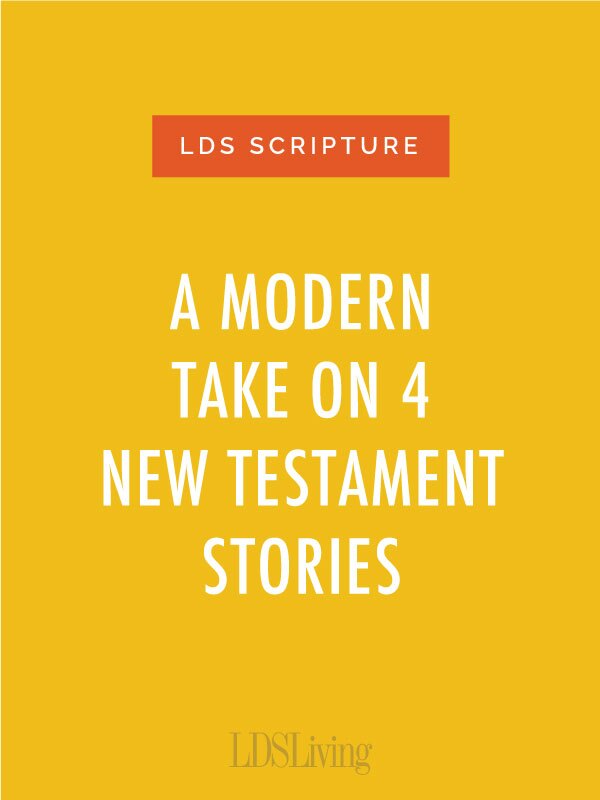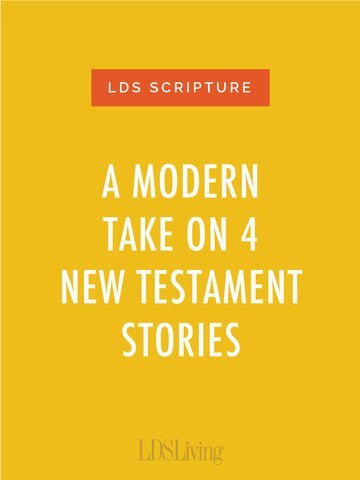
During the early part of this new year, our family made a point of reflecting on the life and teachings of the Savior. Through this reflection, it has become even more apparent how the lessons and parables Christ taught still have significance in our day. Given the confusion and turbulence of our time, the state of the world, and the conditions of families and individuals, we are all in desperate need of His counsel. So, here are four New Testament stories that can teach us how to handle the stresses and challenge of our modern world.
Fishers of Men—Putting Aside Important Things for a Greater Purpose
Matthew 4:18-22; Mark 1:16-20; Luke 5:1-11
In our first story, Jesus is teaching by the Sea of Galilee when he sees Simon Peter and his brother, Andrew, fishing. When He finishes teaching, He calls to Peter and instructs him to cast his net into the sea. Peter replies that they have been working all night without catching any fish, but then he still chooses to let down his net. When he does, they catch so many fish that it breaks their net and they have to call for more help to get the fish into the ships. When they return to shore, Jesus instructs them to leave their nets and follow Him. They would soon become fishers of men as Peter, Andrew, James, and John, “forsook all and followed him.”
I imagine that they were tired and discouraged from working all night without any success. Luke’s account also describes how Peter was lacking in faith, but became humble at the recognition of this miracle. However, now that their ships were full of fish, there was probably more work to be done. It was probably an inconvenient time for Christ to ask them to leave, but they didn’t make excuses. They didn’t say that they needed to finish with their work first, but rather, they “straightway left their nets, and followed him.”
Elder Joseph B. Wirthlin gives more insight into this story:
“Have you ever wondered what it must have been like to have lived in the days of the Savior? If you had been there, would you have heeded His call ‘Follow me?’ Perhaps a more realistic question might be, ‘If the Savior were to call you today, would you be just as willing to leave your nets and follow Him?’ I am confident that many would. But for some, it may not be such an easy decision. Some have discovered that nets, by their very nature, are sometimes not so easy to leave…
“Nets are generally defined as devices for capturing something. In a more narrow but more important sense, we might define a net as anything that entices or prevents us from following the call of Jesus Christ, the Son of the living God. Nets in this context can be our work, our hobbies, our pleasures, and above all else, our temptations and sins. In short, a net can be anything that pulls us away from our relationship with our Heavenly Father or from His restored Church.”
What might be your net? What have the prophets and apostles asked you to do recently that you might be pushing off? Will you heed their words?
Stilling the Storm—Taking It to the Lord
Matthew 8:23-27; Mark 4:35-41; Luke 8:22-25
Once again, at the start of this story, we find Jesus instructing people by the Sea of Galilee before boarding a ship with His disciples. He then falls asleep just before a massive storm arises–one so powerful that the disciples are fearful for their lives. (Remember, they were experienced fisherman who were probably used to storms.) They wake Jesus, saying, “Master, carest thou not that we perish?” Jesus immediately calms the storm and then asks: “Why are ye fearful?” and “How is it that ye have no faith?” The disciples are astonished, both at His questions and at how the elements could obey so quickly.
To this timeless tale, President Howard W. Hunter adds some additional insight:
“All of us have seen some sudden storms in our lives. A few of them, though temporary like these on the Sea of Galilee, can be violent and frightening and potentially destructive. As individuals, as families, as communities, as nations, even as a church, we have had sudden squalls arise which have made us ask one way or another, ‘Master, carest thou not that we perish?’ And one way or another we always hear in the stillness after the storm, ‘Why are ye so fearful? How is it that ye have no faith?’
“None of us would like to think we have no faith, but I suppose the Lord’s gentle rebuke here is largely deserved. This great Jehovah, in whom we say we trust and whose name we have taken upon us, is he who said, ‘Let there be a firmament in the midst of the waters, and let it divide the waters from the waters.’ And he is also the one who said, ‘Let the waters under the heaven be gathered together unto one place, and let the dry land appear.’ Furthermore, it was he who parted the Red Sea, allowing the Israelites to pass through on dry ground. Certainly it should be no surprise that he could command a few elements acting up on the Sea of Galilee. And our faith should remind us that he can calm the troubled water of our lives.”
We see some great symbolism in this story. The ship can be likened to our own lives, sailing through the waves of the world. Storms arise in our lives and sometimes we get so caught up in the emotions and drama that we forget our faith. We call out, “Lord, don’t you care that…” But this lesson isn’t really about the disciples’ lack of faith in Christ. They give us a great example by taking it to the Lord—that’s why they awoke Jesus. Because, though Christ has given us tools to help us in these storms, He will always be there to rescue us when we need it—if we do our part.
Parable of the Good Samaritan—Cultivating a Christlike Character
Luke 10:25-37
In this story, a lawyer asks Jesus, “Master, what shall I do to inherit eternal life,” and Jesus has him answer his own question. Then the lawyer asks a second question, “And who is my neighbor?” This time, Jesus answers with a reflective parable. The setting of the story is the road between Jerusalem and Jericho, which was known to have thieves that would attack travelers. In the story, a lone traveler falls victim to these thieves and is left for dead. The first to come across this man is a priest, whose job is to minister, but who instead passes by the injured man. The second, a Levite, also fails to provide relief to the wounded man. The third person, a Samaritan, stops to give aid to the man. He cleans him up and takes him to an inn where he continues his care. He needs to leave the next morning, but he leaves money for the innkeeper to complete the care of the traveler. The Jews hated the Samaritans and thought of them as enemies, so it is significant that a perceived “enemy” ends up saving the life of the traveler.
At the time when Jesus gave this parable, tradition stated that the neighbor of a Jew was another Jew. A Gentile, or anyone else who opposed Jewish teachings, was often considered an enemy. The Law of Moses taught that you should “love your neighbor,” but Jesus was teaching a higher law: everyone is your neighbor and we should treat everyone with love and compassion.
Like Christ, Bishop H. David Burton reminds us of who our neighbors are and what our obligations are towards them:
“To help relieve suffering is to cultivate a Christlike character. We are charged, as were those who listened at the feet of the Savior 2,000 years ago, to ‘go, and do thou likewise.’ The Prophet Joseph Smith taught that it is our responsibility ‘to feed the hungry, to clothe the naked, to provide for the widow, to dry up the tear of the orphan, to comfort the afflicted, whether in this church or in any other, or in no church at all, wherever he finds them.’”
Sometimes we get stuck in our little circle and forget who our neighbor is. It is easy to serve and care for our friends and our church “neighbors,” but when you become aware and mindful of others around you in your community, suddenly there are so many creative ways to reach out, lift up, and inspire. Get yourself in the habit of not passing by. There is always something you can do to alleviate another’s suffering.
Cleansing the Temple—Learning Love and Limits
Matthew 21:12-17; Mark 11:15-19; Luke 19:45-48
Just after his grand arrival at Jerusalem, Jesus and His disciples enter the temple. Inside, they find people buying and selling goods. Jesus, seeing this, immediately casts them out and overthrows the table of the moneychangers. He declares the temple a “house of prayer” and, once everything is calm, resumes His teaching and heals all that came forth to be healed.
This was not the first time Christ cleansed the temple during His ministry. He makes it clear through these examples that the temple is a sacred place to be used for worship and teaching. It is not a place of commerce or commonplace practices. Jesus also taught about limits and boundaries, which are still applicable today. It seems that many people feel that limits restrict our freedom when, in fact, there is liberty in righteousness.
Elder Russell M. Nelson explains:
“The Lord drew boundary lines to define acceptable limits of tolerance. Danger arises when those divine limits are disobeyed. Just as parents teach little children not to run and play in the street, the Savior taught us that we need not tolerate evil. ‘Jesus went into the temple of God… and overthrew the tables of the moneychangers.’ Though He loved the sinner, the Lord said that He ‘cannot look upon sin with the least degree of allowance’…
“Our commitment to the Savior causes us to scorn sin yet heed His commandment to love our neighbors. Together we live in this earth, which is to be tended, subdued, and shared with gratitude. Each of us can help make life in this world a more pleasant experience…
“Unitedly we may respond. Together we may stand, intolerant of transgression but tolerant of neighbors with differences they hold sacred. Our beloved brothers and sisters throughout the world are all children of God.”
Jefra Rees is the wife of a loving husband and the mother of a young son with sensory processing challenges. She holds a Bachelor's Degree in Child Development and also has a Master's Degree in Early Childhood Special Education, both from the University of Texas at Austin. She has worked with children and families in a variety of settings, but her greatest work is that which is done in her own home. She and her family currently live in Brooklyn, NY.


